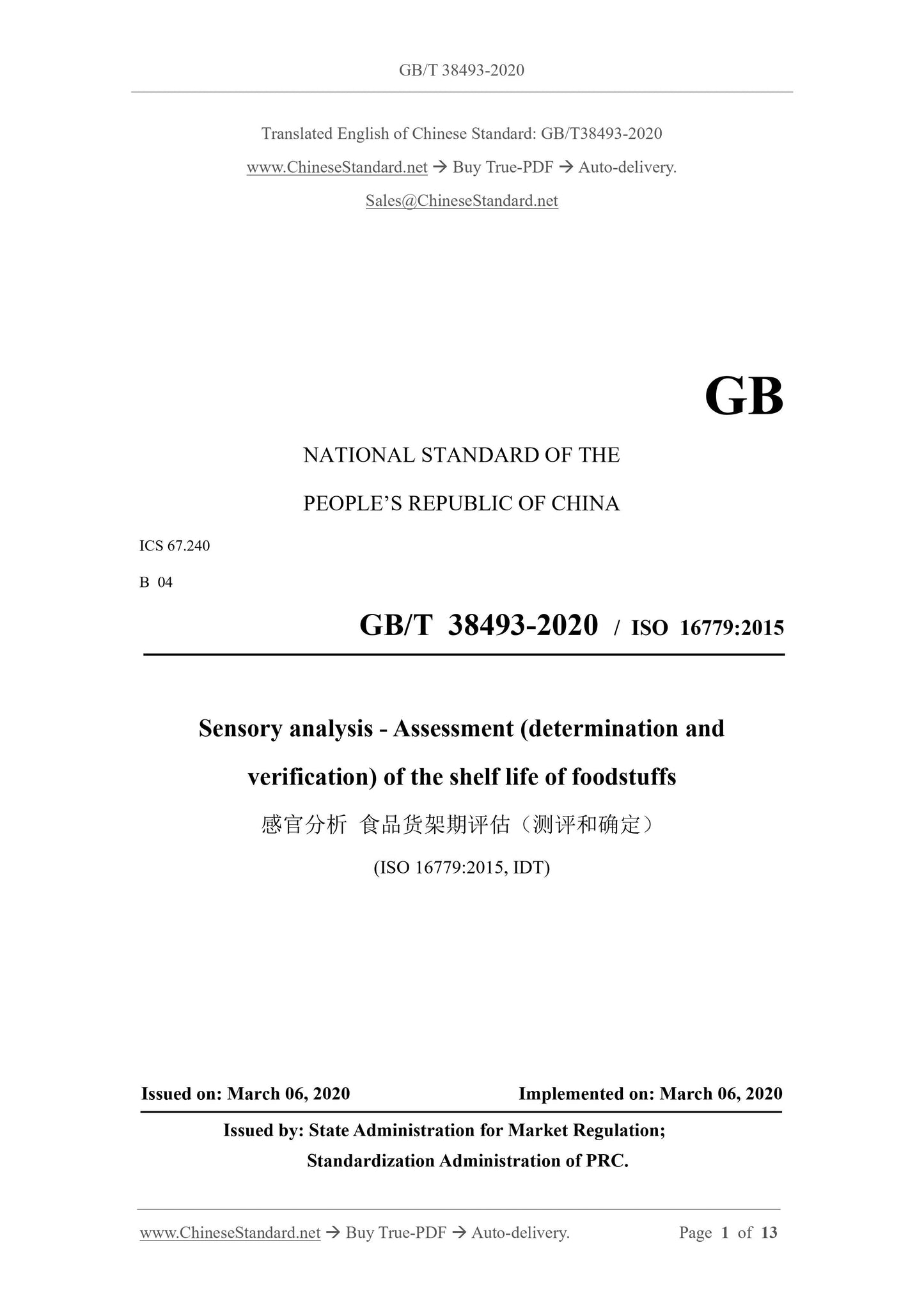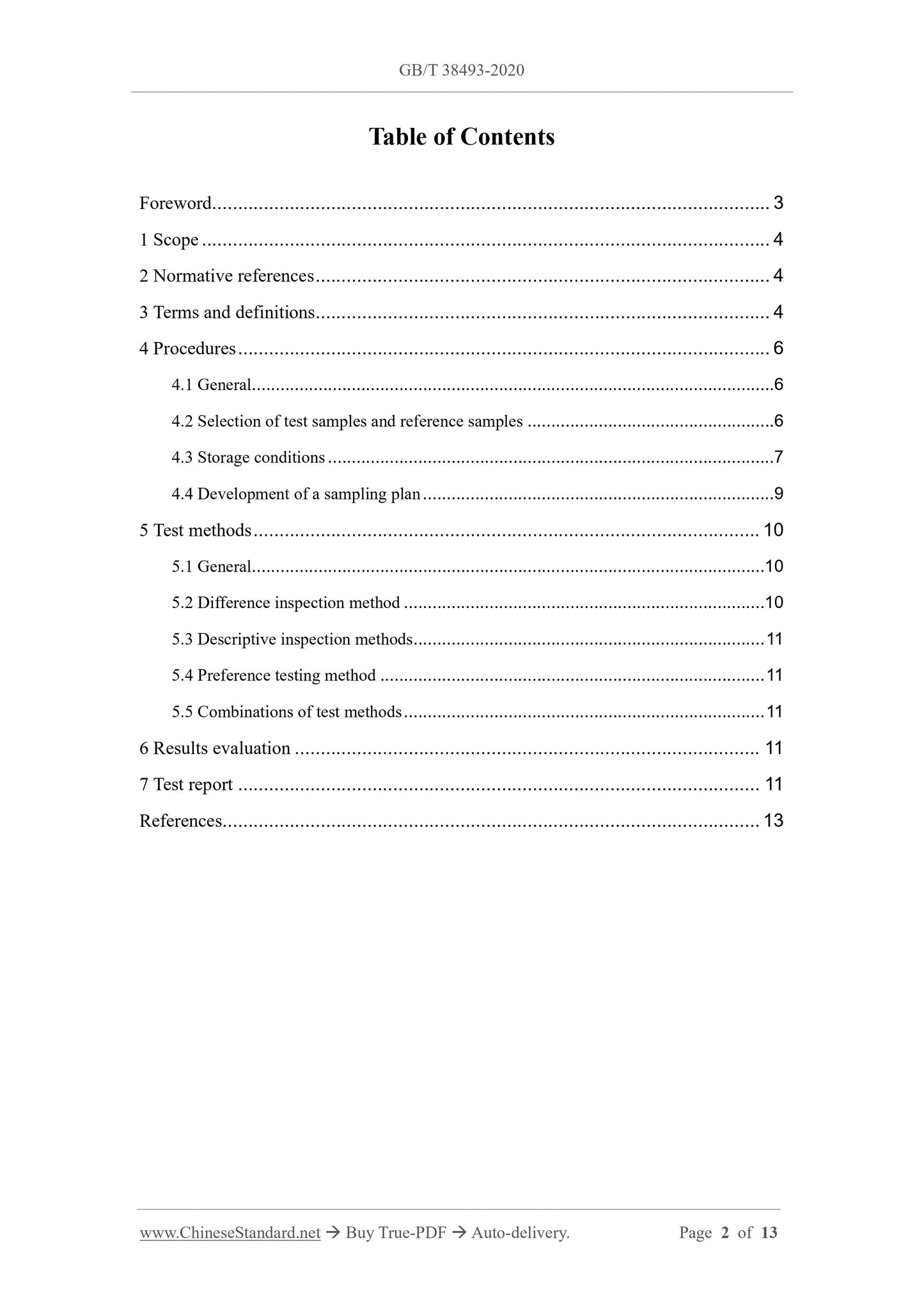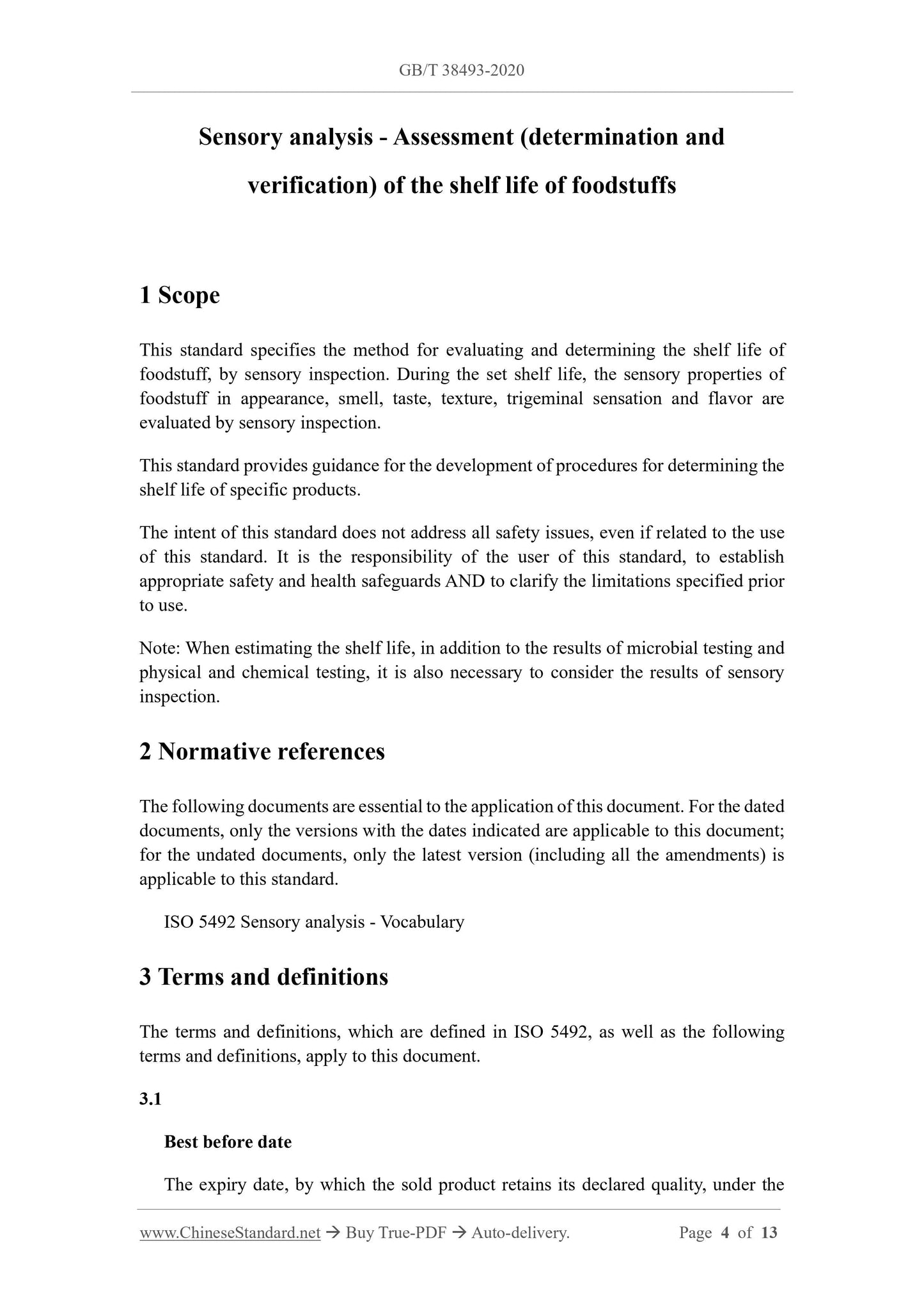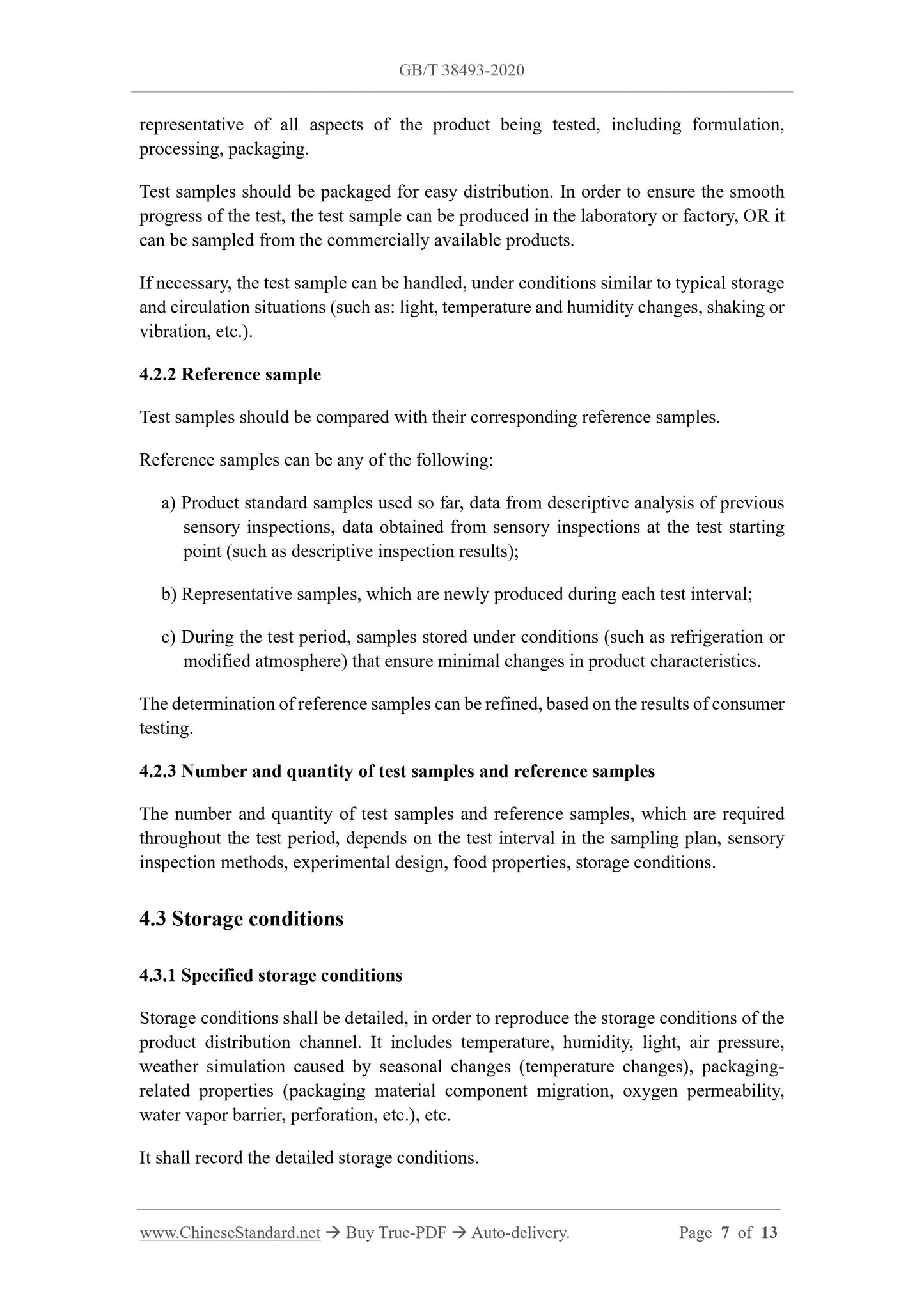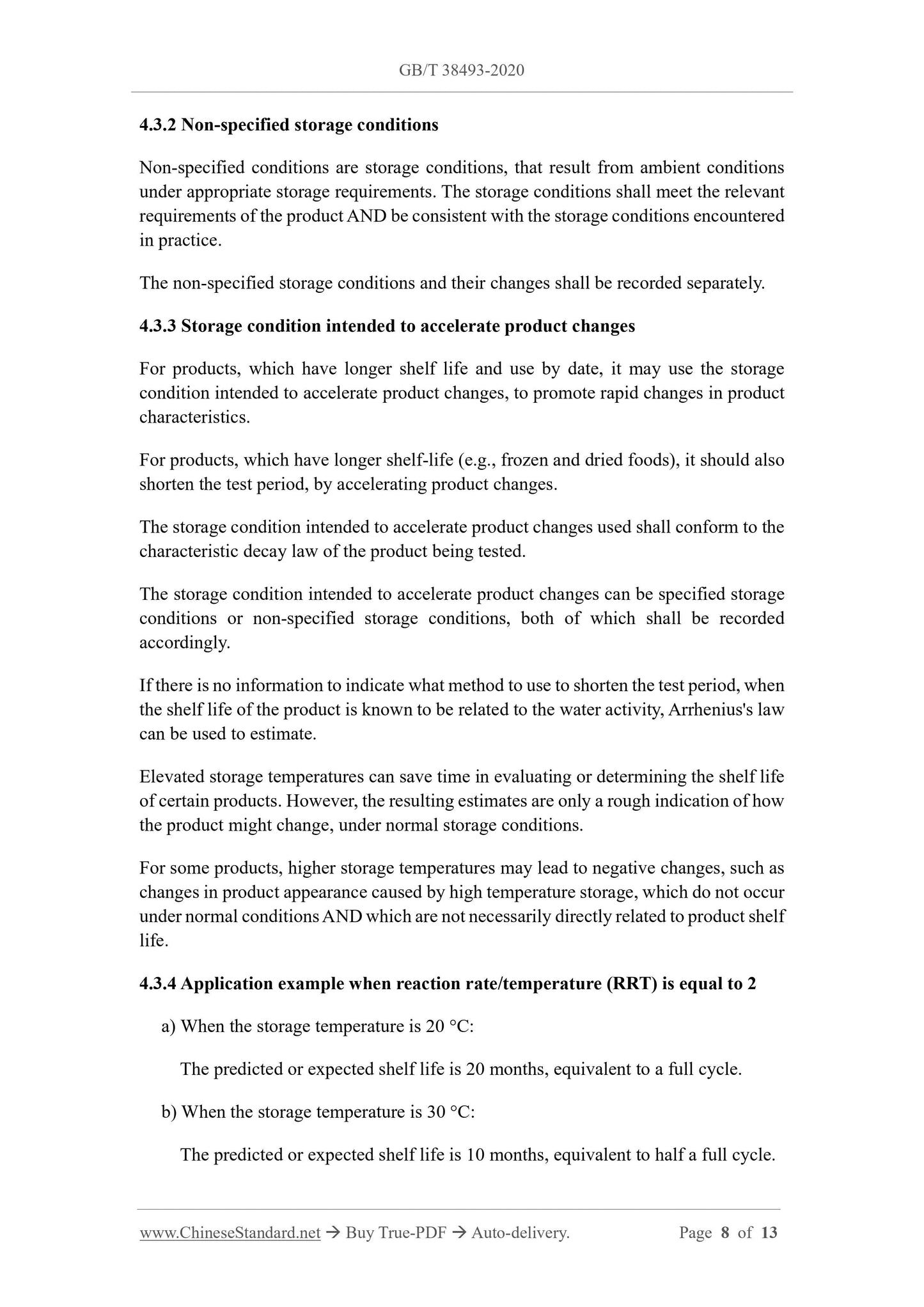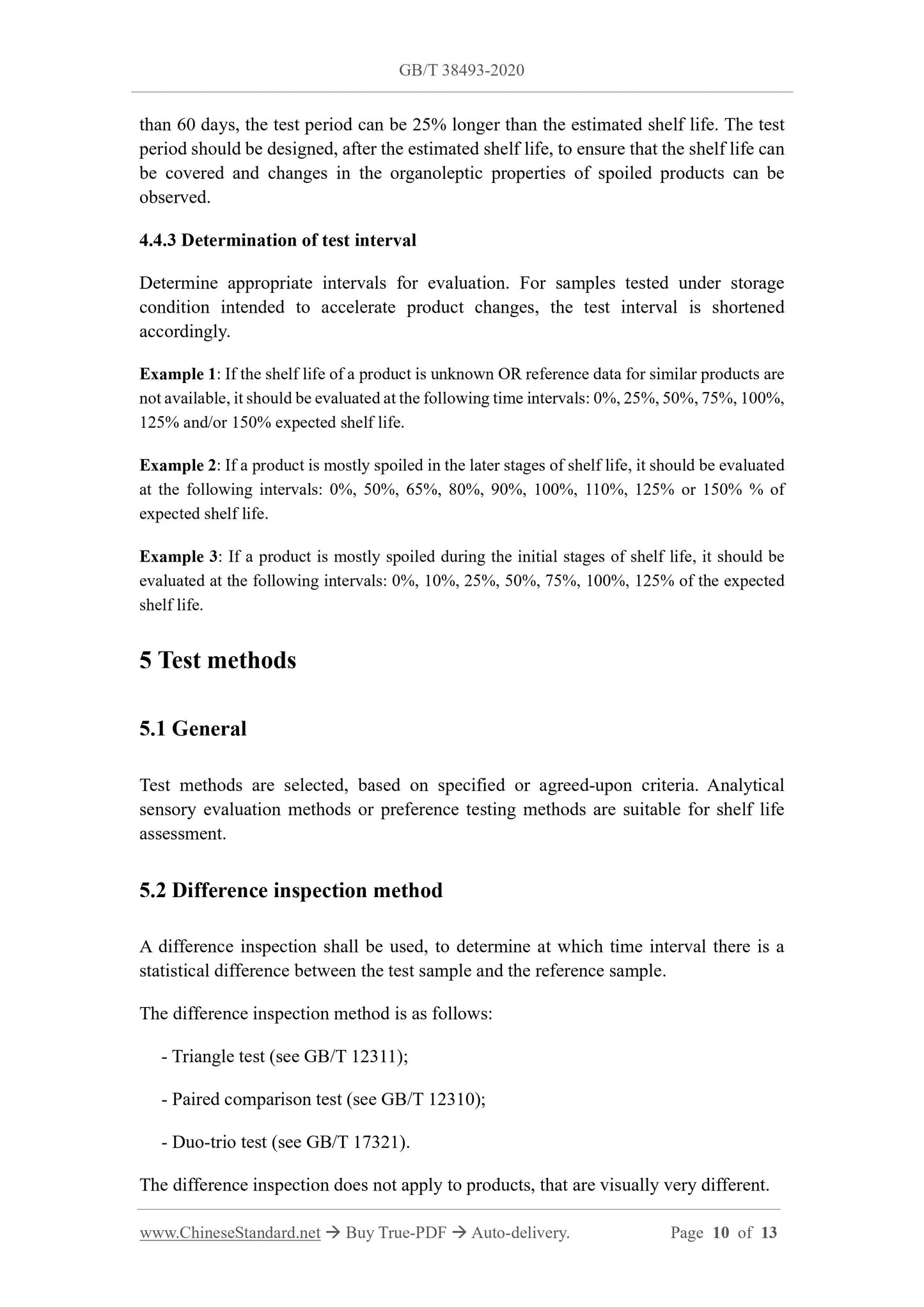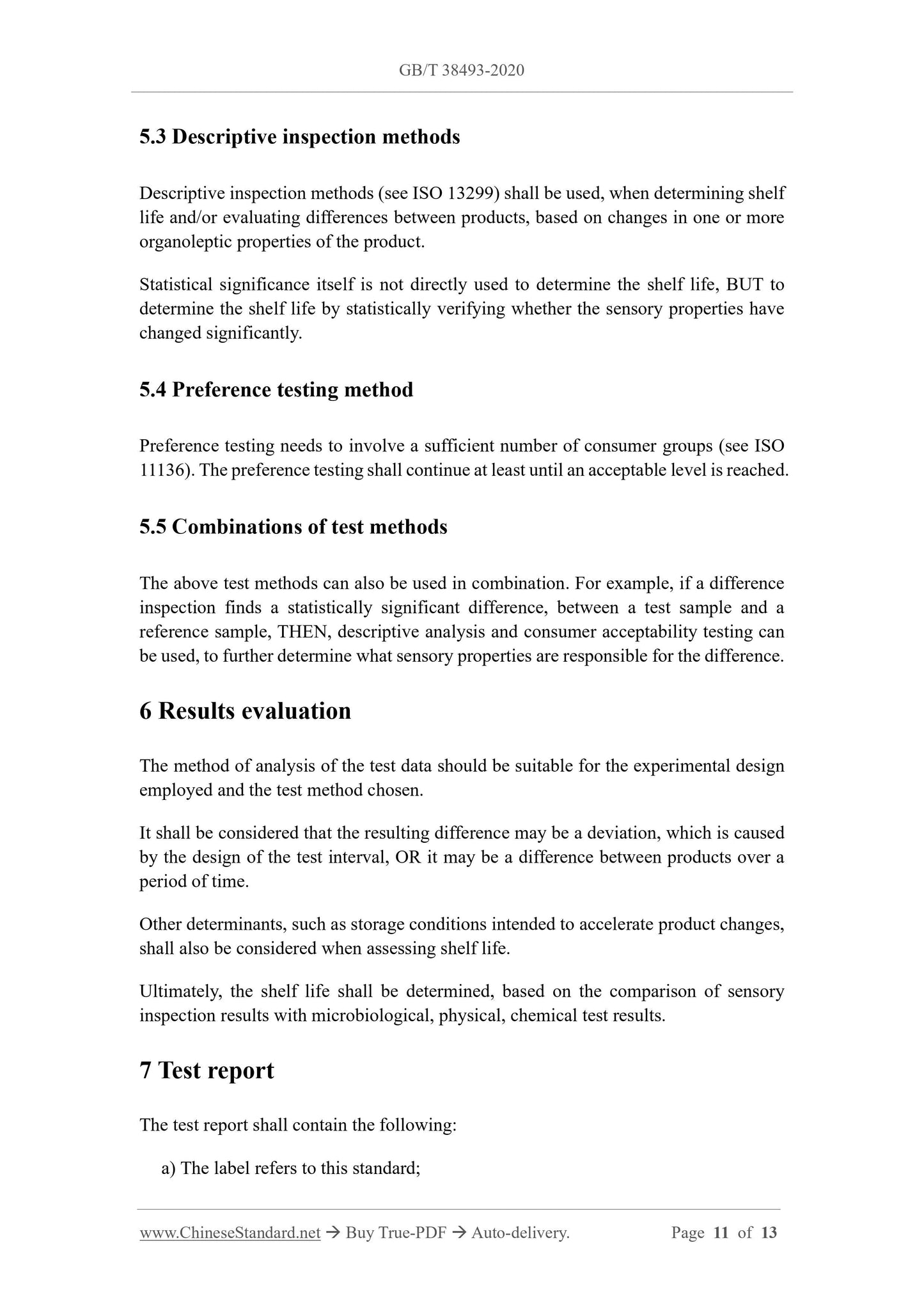1
/
of
7
www.ChineseStandard.us -- Field Test Asia Pte. Ltd.
GB/T 38493-2020 English PDF (GB/T38493-2020)
GB/T 38493-2020 English PDF (GB/T38493-2020)
Regular price
$165.00
Regular price
Sale price
$165.00
Unit price
/
per
Shipping calculated at checkout.
Couldn't load pickup availability
GB/T 38493-2020: Sensory analysis - Assessment (determination and verification) of the shelf life of foodstuffs
Delivery: 9 seconds. Download (& Email) true-PDF + Invoice.
Get Quotation: Click GB/T 38493-2020 (Self-service in 1-minute)
Historical versions (Master-website): GB/T 38493-2020
Preview True-PDF (Reload/Scroll-down if blank)
GB/T 38493-2020
NATIONAL STANDARD OF THE
PEOPLE’S REPUBLIC OF CHINA
ICS 67.240
B 04
GB/T 38493-2020 / ISO 16779:2015
Sensory analysis - Assessment (determination and
verification) of the shelf life of foodstuffs
(ISO 16779:2015, IDT)
ISSUED ON: MARCH 06, 2020
IMPLEMENTED ON: MARCH 06, 2020
Issued by: State Administration for Market Regulation;
Standardization Administration of PRC.
Table of Contents
Foreword ... 3
1 Scope ... 4
2 Normative references ... 4
3 Terms and definitions... 4
4 Procedures ... 6
4.1 General... 6
4.2 Selection of test samples and reference samples ... 6
4.3 Storage conditions ... 7
4.4 Development of a sampling plan ... 9
5 Test methods ... 10
5.1 General... 10
5.2 Difference inspection method ... 10
5.3 Descriptive inspection methods ... 11
5.4 Preference testing method ... 11
5.5 Combinations of test methods ... 11
6 Results evaluation ... 11
7 Test report ... 11
References ... 13
Sensory analysis - Assessment (determination and
verification) of the shelf life of foodstuffs
1 Scope
This standard specifies the method for evaluating and determining the shelf life of
foodstuff, by sensory inspection. During the set shelf life, the sensory properties of
foodstuff in appearance, smell, taste, texture, trigeminal sensation and flavor are
evaluated by sensory inspection.
This standard provides guidance for the development of procedures for determining the
shelf life of specific products.
The intent of this standard does not address all safety issues, even if related to the use
of this standard. It is the responsibility of the user of this standard, to establish
appropriate safety and health safeguards AND to clarify the limitations specified prior
to use.
Note: When estimating the shelf life, in addition to the results of microbial testing and
physical and chemical testing, it is also necessary to consider the results of sensory
inspection.
2 Normative references
The following documents are essential to the application of this document. For the dated
documents, only the versions with the dates indicated are applicable to this document;
for the undated documents, only the latest version (including all the amendments) is
applicable to this standard.
ISO 5492 Sensory analysis - Vocabulary
3 Terms and definitions
The terms and definitions, which are defined in ISO 5492, as well as the following
terms and definitions, apply to this document.
3.1
Best before date
The expiry date, by which the sold product retains its declared quality, under the
representative of all aspects of the product being tested, including formulation,
processing, packaging.
Test samples should be packaged for easy distribution. In order to ensure the smooth
progress of the test, the test sample can be produced in the laboratory or factory, OR it
can be sampled from the commercially available products.
If necessary, the test sample can be handled, under conditions similar to typical storage
and circulation situations (such as: light, temperature and humidity changes, shaking or
vibration, etc.).
4.2.2 Reference sample
Test samples should be compared with their corresponding reference samples.
Reference samples can be any of the following:
a) Product standard samples used so far, data from descriptive analysis of previous
sensory inspections, data obtained from sensory inspections at the test starting
point (such as descriptive inspection results);
b) Representative samples, which are newly produced during each test interval;
c) During the test period, samples stored under conditions (such as refrigeration or
modified atmosphere) that ensure minimal changes in product characteristics.
The determination of reference samples can be refined, based on the results of consumer
testing.
4.2.3 Number and quantity of test samples and reference samples
The number and quantity of test samples and reference samples, which are required
throughout the test period, depends on the test interval in the sampling plan, sensory
inspection methods, experimental design, food properties, storage conditions.
4.3 Storage conditions
4.3.1 Specified storage conditions
Storage conditions shall be detailed, in order to reproduce the storage conditions of the
product distribution channel. It includes temperature, humidity, light, air pressure,
weather simulation caused by seasonal changes (temperature changes), packaging-
related properties (packaging material component migration, oxygen permeability,
water vapor barrier, perforation, etc.), etc.
It shall record the detailed storage conditions.
4.3.2 Non-specified storage conditions
Non-specified conditions are storage conditions, that result from ambient conditions
under appropriate storage requirements. The storage conditions shall meet the relevant
requirements of the product AND be consistent with the storage conditions encountered
in practice.
The non-specified storage conditions and their changes shall be recorded separately.
4.3.3 Storage condition intended to accelerate product changes
For products, which have longer shelf life and use by date, it may use the storage
condition intended to accelerate product changes, to promote rapid changes in product
characteristics.
For products, which have longer shelf-life (e.g., frozen and dried foods), it should also
shorten the test period, by accelerating product changes.
The storage condition intended to accelerate product changes used shall conform to the
characteristic decay law of the product being tested.
The storage condition intended to accelerate product changes can be specified storage
conditions or non-specified storage conditions, both of which shall be recorded
accordingly.
If there is no information to indicate what method to use to shorten the test period, when
the shelf life of the product is known to be related to the water activity, Arrhenius's law
can be used to estimate.
Elevated storage temperatures can save time in evaluating or determining the shelf life
of certain products. However, the resulting estimates are only a rough indication of how
the product might change, under normal storage conditions.
For some products, higher storage temperatures may lead to negative changes, such as
changes in product appearance caused by high temperature storage, which do not occur
under normal conditions AND which are not necessarily directly related to product shelf
life.
4.3.4 Application example when reaction rate/temperature (RRT) is equal to 2
a) When the storage temperature is 20 °C:
The predicted or expected shelf life is 20 months, equivalent to a full cycle.
b) When the storage temperature is 30 °C:
The predicted or expected shelf life is 10 months, equivalent to half a full cycle.
than 60 days, the test period can be 25% longer than the estimated shelf life. The test
period should be designed, after the estimated shelf life, to ensure that the shelf life can
be covered and changes in the organoleptic properties of spoiled products can be
observed.
4.4.3 Determination of test interval
Determine appropriate intervals for evaluation. For samples tested under storage
condition intended to accelerate product changes, the test interval is shortened
accordingly.
Example 1: If the shelf life of a product is unknown OR reference data for similar products are
not available, it should be evaluated at the following time intervals: 0%, 25%, 50%, 75%, 100%,
125% and/or 150% expected shelf life.
Example 2: If a product is mostly spoiled in the later stages of shelf life, it should be evaluated
at the following intervals: 0%, 50%, 65%, 80%, 90%, 100%, 110%, 125% or 150% % of
expected shelf life.
Example 3: If a product is mostly spoiled during the initial stages of shelf life, it should be
evaluated at the following intervals: 0%, 10%, 25%, 50%, 75%, 100%, 125% of the expected
shelf life.
5 Test methods
5.1 General
Test methods are selected, based on specified or agreed-upon criteria. Analytical
sensory evaluation methods or preference testing methods are suitable for shelf life
assessment.
5.2 Difference inspection method
A difference inspection shall be used, to determine at which time interval there is a
statistical difference between the test sample and the reference sample.
The difference inspection method is as follows:
- Triangle test (see GB/T 12311);
- Paired comparison test (see GB/T 12310);
- Duo-trio test (see GB/T 17321).
The difference inspection does not apply to products, that are visually very different.
5.3 Descriptive inspection methods
Descriptive inspection methods (see ISO 13299) shall be used, when determining shelf
life and/or evaluating differences between products, based on changes in one or more
organoleptic properties of the product.
Statistical significance itself is not directly used to determine the shelf life, BUT to
determine the shelf life by statistically verifying whether the sensory properties have
changed significantly.
5.4 Preference testing method
Preference testing needs to involve a sufficient number of consumer groups (see ISO
11136). The preference testing shall continue at least until an acceptable level is reached.
5.5 Combinations of test methods
The above test methods can also be used in combination. For example, if a difference
inspection finds a statistically significant difference, between a test sample and a
reference sample, THEN, descriptive analysis and consumer acceptability testing can
be used, to further determine what sensory properties are responsible for the difference.
6 Results evaluation
The method of analysis of the test data should be suitable for the experimental design
employed and the test method chosen.
It shall be considered that the resulting difference may be a deviation, which is caused
by the design of the test interval, OR it may be a difference between products over a
period of time.
Other determinants, such as storage conditions intended to accelerate product changes,
shall also be considered when assessing shelf life.
Ultimately, the shelf life shall be determined, based on the comparison of sensory
inspection results with microbiological, physical, chemical test results.
7 Test report
The test report shall contain the following:
a) The label refers to this standard;
GB/T 38493-2020
NATIONAL STANDARD OF THE
PEOPLE’S REPUBLIC OF CHINA
ICS 67.240
B 04
GB/T 38493-2020 / ISO 16779:2015
Sensory analysis - Assessment (determination and
verification) of the shelf life of foodstuffs
(ISO 16779:2015, IDT)
ISSUED ON: MARCH 06, 2020
IMPLEMENTED ON: MARCH 06, 2020
Issued by: State Administration for Market Regulation;
Standardization Administration of PRC.
Table of Contents
Foreword ... 3
1 Scope ... 4
2 Normative references ... 4
3 Terms and definitions... 4
4 Procedures ... 6
4.1 General... 6
4.2 Selection of test samples and reference samples ... 6
4.3 Storage conditions ... 7
4.4 Development of a sampling plan ... 9
5 Test methods ... 10
5.1 General... 10
5.2 Difference inspection method ... 10
5.3 Descriptive inspection methods ... 11
5.4 Preference testing method ... 11
5.5 Combinations of test methods ... 11
6 Results evaluation ... 11
7 Test report ... 11
References ... 13
Sensory analysis - Assessment (determination and
verification) of the shelf life of foodstuffs
1 Scope
This standard specifies the method for evaluating and determining the shelf life of
foodstuff, by sensory inspection. During the set shelf life, the sensory properties of
foodstuff in appearance, smell, taste, texture, trigeminal sensation and flavor are
evaluated by sensory inspection.
This standard provides guidance for the development of procedures for determining the
shelf life of specific products.
The intent of this standard does not address all safety issues, even if related to the use
of this standard. It is the responsibility of the user of this standard, to establish
appropriate safety and health safeguards AND to clarify the limitations specified prior
to use.
Note: When estimating the shelf life, in addition to the results of microbial testing and
physical and chemical testing, it is also necessary to consider the results of sensory
inspection.
2 Normative references
The following documents are essential to the application of this document. For the dated
documents, only the versions with the dates indicated are applicable to this document;
for the undated documents, only the latest version (including all the amendments) is
applicable to this standard.
ISO 5492 Sensory analysis - Vocabulary
3 Terms and definitions
The terms and definitions, which are defined in ISO 5492, as well as the following
terms and definitions, apply to this document.
3.1
Best before date
The expiry date, by which the sold product retains its declared quality, under the
representative of all aspects of the product being tested, including formulation,
processing, packaging.
Test samples should be packaged for easy distribution. In order to ensure the smooth
progress of the test, the test sample can be produced in the laboratory or factory, OR it
can be sampled from the commercially available products.
If necessary, the test sample can be handled, under conditions similar to typical storage
and circulation situations (such as: light, temperature and humidity changes, shaking or
vibration, etc.).
4.2.2 Reference sample
Test samples should be compared with their corresponding reference samples.
Reference samples can be any of the following:
a) Product standard samples used so far, data from descriptive analysis of previous
sensory inspections, data obtained from sensory inspections at the test starting
point (such as descriptive inspection results);
b) Representative samples, which are newly produced during each test interval;
c) During the t...
Delivery: 9 seconds. Download (& Email) true-PDF + Invoice.
Get Quotation: Click GB/T 38493-2020 (Self-service in 1-minute)
Historical versions (Master-website): GB/T 38493-2020
Preview True-PDF (Reload/Scroll-down if blank)
GB/T 38493-2020
NATIONAL STANDARD OF THE
PEOPLE’S REPUBLIC OF CHINA
ICS 67.240
B 04
GB/T 38493-2020 / ISO 16779:2015
Sensory analysis - Assessment (determination and
verification) of the shelf life of foodstuffs
(ISO 16779:2015, IDT)
ISSUED ON: MARCH 06, 2020
IMPLEMENTED ON: MARCH 06, 2020
Issued by: State Administration for Market Regulation;
Standardization Administration of PRC.
Table of Contents
Foreword ... 3
1 Scope ... 4
2 Normative references ... 4
3 Terms and definitions... 4
4 Procedures ... 6
4.1 General... 6
4.2 Selection of test samples and reference samples ... 6
4.3 Storage conditions ... 7
4.4 Development of a sampling plan ... 9
5 Test methods ... 10
5.1 General... 10
5.2 Difference inspection method ... 10
5.3 Descriptive inspection methods ... 11
5.4 Preference testing method ... 11
5.5 Combinations of test methods ... 11
6 Results evaluation ... 11
7 Test report ... 11
References ... 13
Sensory analysis - Assessment (determination and
verification) of the shelf life of foodstuffs
1 Scope
This standard specifies the method for evaluating and determining the shelf life of
foodstuff, by sensory inspection. During the set shelf life, the sensory properties of
foodstuff in appearance, smell, taste, texture, trigeminal sensation and flavor are
evaluated by sensory inspection.
This standard provides guidance for the development of procedures for determining the
shelf life of specific products.
The intent of this standard does not address all safety issues, even if related to the use
of this standard. It is the responsibility of the user of this standard, to establish
appropriate safety and health safeguards AND to clarify the limitations specified prior
to use.
Note: When estimating the shelf life, in addition to the results of microbial testing and
physical and chemical testing, it is also necessary to consider the results of sensory
inspection.
2 Normative references
The following documents are essential to the application of this document. For the dated
documents, only the versions with the dates indicated are applicable to this document;
for the undated documents, only the latest version (including all the amendments) is
applicable to this standard.
ISO 5492 Sensory analysis - Vocabulary
3 Terms and definitions
The terms and definitions, which are defined in ISO 5492, as well as the following
terms and definitions, apply to this document.
3.1
Best before date
The expiry date, by which the sold product retains its declared quality, under the
representative of all aspects of the product being tested, including formulation,
processing, packaging.
Test samples should be packaged for easy distribution. In order to ensure the smooth
progress of the test, the test sample can be produced in the laboratory or factory, OR it
can be sampled from the commercially available products.
If necessary, the test sample can be handled, under conditions similar to typical storage
and circulation situations (such as: light, temperature and humidity changes, shaking or
vibration, etc.).
4.2.2 Reference sample
Test samples should be compared with their corresponding reference samples.
Reference samples can be any of the following:
a) Product standard samples used so far, data from descriptive analysis of previous
sensory inspections, data obtained from sensory inspections at the test starting
point (such as descriptive inspection results);
b) Representative samples, which are newly produced during each test interval;
c) During the test period, samples stored under conditions (such as refrigeration or
modified atmosphere) that ensure minimal changes in product characteristics.
The determination of reference samples can be refined, based on the results of consumer
testing.
4.2.3 Number and quantity of test samples and reference samples
The number and quantity of test samples and reference samples, which are required
throughout the test period, depends on the test interval in the sampling plan, sensory
inspection methods, experimental design, food properties, storage conditions.
4.3 Storage conditions
4.3.1 Specified storage conditions
Storage conditions shall be detailed, in order to reproduce the storage conditions of the
product distribution channel. It includes temperature, humidity, light, air pressure,
weather simulation caused by seasonal changes (temperature changes), packaging-
related properties (packaging material component migration, oxygen permeability,
water vapor barrier, perforation, etc.), etc.
It shall record the detailed storage conditions.
4.3.2 Non-specified storage conditions
Non-specified conditions are storage conditions, that result from ambient conditions
under appropriate storage requirements. The storage conditions shall meet the relevant
requirements of the product AND be consistent with the storage conditions encountered
in practice.
The non-specified storage conditions and their changes shall be recorded separately.
4.3.3 Storage condition intended to accelerate product changes
For products, which have longer shelf life and use by date, it may use the storage
condition intended to accelerate product changes, to promote rapid changes in product
characteristics.
For products, which have longer shelf-life (e.g., frozen and dried foods), it should also
shorten the test period, by accelerating product changes.
The storage condition intended to accelerate product changes used shall conform to the
characteristic decay law of the product being tested.
The storage condition intended to accelerate product changes can be specified storage
conditions or non-specified storage conditions, both of which shall be recorded
accordingly.
If there is no information to indicate what method to use to shorten the test period, when
the shelf life of the product is known to be related to the water activity, Arrhenius's law
can be used to estimate.
Elevated storage temperatures can save time in evaluating or determining the shelf life
of certain products. However, the resulting estimates are only a rough indication of how
the product might change, under normal storage conditions.
For some products, higher storage temperatures may lead to negative changes, such as
changes in product appearance caused by high temperature storage, which do not occur
under normal conditions AND which are not necessarily directly related to product shelf
life.
4.3.4 Application example when reaction rate/temperature (RRT) is equal to 2
a) When the storage temperature is 20 °C:
The predicted or expected shelf life is 20 months, equivalent to a full cycle.
b) When the storage temperature is 30 °C:
The predicted or expected shelf life is 10 months, equivalent to half a full cycle.
than 60 days, the test period can be 25% longer than the estimated shelf life. The test
period should be designed, after the estimated shelf life, to ensure that the shelf life can
be covered and changes in the organoleptic properties of spoiled products can be
observed.
4.4.3 Determination of test interval
Determine appropriate intervals for evaluation. For samples tested under storage
condition intended to accelerate product changes, the test interval is shortened
accordingly.
Example 1: If the shelf life of a product is unknown OR reference data for similar products are
not available, it should be evaluated at the following time intervals: 0%, 25%, 50%, 75%, 100%,
125% and/or 150% expected shelf life.
Example 2: If a product is mostly spoiled in the later stages of shelf life, it should be evaluated
at the following intervals: 0%, 50%, 65%, 80%, 90%, 100%, 110%, 125% or 150% % of
expected shelf life.
Example 3: If a product is mostly spoiled during the initial stages of shelf life, it should be
evaluated at the following intervals: 0%, 10%, 25%, 50%, 75%, 100%, 125% of the expected
shelf life.
5 Test methods
5.1 General
Test methods are selected, based on specified or agreed-upon criteria. Analytical
sensory evaluation methods or preference testing methods are suitable for shelf life
assessment.
5.2 Difference inspection method
A difference inspection shall be used, to determine at which time interval there is a
statistical difference between the test sample and the reference sample.
The difference inspection method is as follows:
- Triangle test (see GB/T 12311);
- Paired comparison test (see GB/T 12310);
- Duo-trio test (see GB/T 17321).
The difference inspection does not apply to products, that are visually very different.
5.3 Descriptive inspection methods
Descriptive inspection methods (see ISO 13299) shall be used, when determining shelf
life and/or evaluating differences between products, based on changes in one or more
organoleptic properties of the product.
Statistical significance itself is not directly used to determine the shelf life, BUT to
determine the shelf life by statistically verifying whether the sensory properties have
changed significantly.
5.4 Preference testing method
Preference testing needs to involve a sufficient number of consumer groups (see ISO
11136). The preference testing shall continue at least until an acceptable level is reached.
5.5 Combinations of test methods
The above test methods can also be used in combination. For example, if a difference
inspection finds a statistically significant difference, between a test sample and a
reference sample, THEN, descriptive analysis and consumer acceptability testing can
be used, to further determine what sensory properties are responsible for the difference.
6 Results evaluation
The method of analysis of the test data should be suitable for the experimental design
employed and the test method chosen.
It shall be considered that the resulting difference may be a deviation, which is caused
by the design of the test interval, OR it may be a difference between products over a
period of time.
Other determinants, such as storage conditions intended to accelerate product changes,
shall also be considered when assessing shelf life.
Ultimately, the shelf life shall be determined, based on the comparison of sensory
inspection results with microbiological, physical, chemical test results.
7 Test report
The test report shall contain the following:
a) The label refers to this standard;
GB/T 38493-2020
NATIONAL STANDARD OF THE
PEOPLE’S REPUBLIC OF CHINA
ICS 67.240
B 04
GB/T 38493-2020 / ISO 16779:2015
Sensory analysis - Assessment (determination and
verification) of the shelf life of foodstuffs
(ISO 16779:2015, IDT)
ISSUED ON: MARCH 06, 2020
IMPLEMENTED ON: MARCH 06, 2020
Issued by: State Administration for Market Regulation;
Standardization Administration of PRC.
Table of Contents
Foreword ... 3
1 Scope ... 4
2 Normative references ... 4
3 Terms and definitions... 4
4 Procedures ... 6
4.1 General... 6
4.2 Selection of test samples and reference samples ... 6
4.3 Storage conditions ... 7
4.4 Development of a sampling plan ... 9
5 Test methods ... 10
5.1 General... 10
5.2 Difference inspection method ... 10
5.3 Descriptive inspection methods ... 11
5.4 Preference testing method ... 11
5.5 Combinations of test methods ... 11
6 Results evaluation ... 11
7 Test report ... 11
References ... 13
Sensory analysis - Assessment (determination and
verification) of the shelf life of foodstuffs
1 Scope
This standard specifies the method for evaluating and determining the shelf life of
foodstuff, by sensory inspection. During the set shelf life, the sensory properties of
foodstuff in appearance, smell, taste, texture, trigeminal sensation and flavor are
evaluated by sensory inspection.
This standard provides guidance for the development of procedures for determining the
shelf life of specific products.
The intent of this standard does not address all safety issues, even if related to the use
of this standard. It is the responsibility of the user of this standard, to establish
appropriate safety and health safeguards AND to clarify the limitations specified prior
to use.
Note: When estimating the shelf life, in addition to the results of microbial testing and
physical and chemical testing, it is also necessary to consider the results of sensory
inspection.
2 Normative references
The following documents are essential to the application of this document. For the dated
documents, only the versions with the dates indicated are applicable to this document;
for the undated documents, only the latest version (including all the amendments) is
applicable to this standard.
ISO 5492 Sensory analysis - Vocabulary
3 Terms and definitions
The terms and definitions, which are defined in ISO 5492, as well as the following
terms and definitions, apply to this document.
3.1
Best before date
The expiry date, by which the sold product retains its declared quality, under the
representative of all aspects of the product being tested, including formulation,
processing, packaging.
Test samples should be packaged for easy distribution. In order to ensure the smooth
progress of the test, the test sample can be produced in the laboratory or factory, OR it
can be sampled from the commercially available products.
If necessary, the test sample can be handled, under conditions similar to typical storage
and circulation situations (such as: light, temperature and humidity changes, shaking or
vibration, etc.).
4.2.2 Reference sample
Test samples should be compared with their corresponding reference samples.
Reference samples can be any of the following:
a) Product standard samples used so far, data from descriptive analysis of previous
sensory inspections, data obtained from sensory inspections at the test starting
point (such as descriptive inspection results);
b) Representative samples, which are newly produced during each test interval;
c) During the t...
Share
